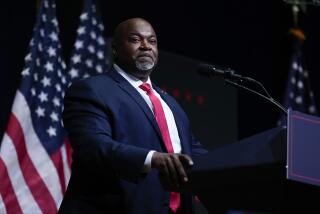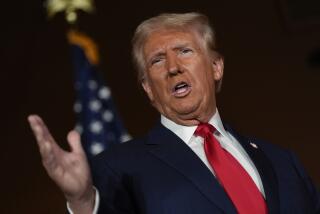Covering the DNC: Too Little, Too Much
Friday morning quarterbacking.
Take it from one who was posted in front of four sets through much of the Democratic National Convention: If there was ever a missed opportunity during overcooked reportage by cable’s 24-hour news channels--which had gobs and gobs of time to fill--it was their failure to use this opportunity to present a panoramic view of Los Angeles to the rest of the nation.
Not La-La Land stereotypes, not celebrities at play, not surfboarders, not Lakers glory, not body bags, not gridlocked freeways, not earthquakes, mudslides or wildfires. All exist here, of course, but are so widely publicized that they have coalesced into a defining caricature of Los Angeles that excludes all else.
We are the multitudes, after all.
Even with all of our problems, there is infinitely more good than bad here. Inevitably absent from national newscasts, and usually from even the city’s local news programs, is the great bulk of metropolitan L.A., the rich ethnic, cultural, artistic and topographical diversity that makes it and the rest of Southern California a fascinating place to be around.
Instead of running one predictable dialogue after another with partisan Democrats, and equally predictable diatribes against them by their critics, why didn’t the news channels take a run through a canyon and inhale that intoxicating beauty? Or visit some of the Spanish missions whose histories thread the fabric of the state? You needn’t be a California chauvinist to find them enthralling.
Instead of repeating for the umpteenth time that Al Gore must separate himself from Bill Clinton to defeat George W. Bush in the presidential election, why didn’t they poke around in a few neighborhoods and explore a bit of urban living history as Huell Howser does regularly on KCET? Too tedious? And the convention wasn’t?
Instead of speculating ad nauseam about what Gore’s running mate, Sen. Joseph I. Lieberman, would have to tell delegates Wednesday night to help the Democratic ticket, why didn’t they spend a few minutes looking in on the Huntington Library? Hey, that’s a thought. Or tour L.A.’s museums? Not just the Getty Center, LACMA and MOCA, but the cul-de-sacs of galleries and other arts that may not be visible from the main drag.
They also could check in with Little Tokyo. And Orange County. They could have profiled the influential Trinity Broadcasting Network. Speaking of the family values to which both political parties ardently give lip service, they could have popped in on occupants of the tract homes that stretch across our valleys. And in the process, of course, learned what came down so that they could come up.
In other words, why didn’t these all-news channels open their eyes and imaginations the way they did their camera lenses? The way NBC, to the dismay of avid sports watchers no doubt, will surely provide an extended travelogue to entice a broader audience when telecasting the coming 2000 Summer Olympics in Australia.
NBC could have used that approach with convention coverage it ran on MSNBC, the cable news channel it runs with Microsoft. But it chose not to.
It’s something you could have predicted. TV historically looks only straight ahead, observing a narrow world that ignores and gives viewers no insight into the vastly wider universe beyond the tunnel vision of the lens. That’s one reason Americans tend to regard themselves as the planet’s sole pulse beat, a reality as skewed as delegates and media on the Staples Center floor believing during celebratory fervor that they were at the epicenter of life.
They weren’t. Nor was the TV coverage.
Media should not be a chamber of commerce or PR agent for anyone or anything. Not their jobs. Nor should they be myopic, however, when shackling themselves to prepackaged political conventions where anchor angst is visible, yawns prevail and a dearth of news finds them all huffing and puffing to validate the great expanse of their coverage.
No ideas? All they had to do was pick up a tour book.
*
TV made a decent pass at covering the demonstrations and other volatility outside of Staples Center, as well as the controversial police response to them. No inflammatory TV rhetoric or cameras inciting the demonstrators or taking sides.
Omitted or touched on only superficially, though, were the problems driving many of these activists.
That’s what syndicated columnist Norman Solomon noted Wednesday during a TV chat on PBS about media coverage of the convention. The discussion, in which I participated, was on “The NewsHour With Jim Lehrer,” and Solomon’s impressions were acutely on target. When it comes to local TV, in particular, give them an action story and they’re on it in a flash. Yet the seeds of dissent elude them.
*
Prior to this week, the GOP publicly prodded the TV networks to give no more coverage to Democrats than they did two weeks ago to Republicans meeting in Philadelphia. If meant as a warning, it didn’t work.
Tuesday’s basic stump speeches by both Sen. Edward Kennedy and his niece, Caroline Kennedy, were telecast live, even though they were valueless as news. And Wednesday night’s worshipful nominating speech by Gore’s daughter, Karenna Gore Schiff--including his “surprise” arrival on stage--was carried live not only by ABC but also NBC, which earlier had abdicated coverage almost exclusively to its sister channel, MSNBC.
If the Republicans are mad, they have every right to be.
*
I didn’t see it, but was told President Clinton’s electrifying speech Monday night was widely watched on huge screens inside Staples--magnifying him into some kind of otherworldly presence--as if the preferred reality for many of these delegates was television instead of the man actually addressing them from the podium.
True or not, it’s a thought, as Americans immerse themselves--almost as participants--in “Survivor” and other entertainment series billed as “reality.”
This confusion is not new. Inside the Notre Dame cathedral in Paris is a small, dimly lit room with a large window through which one can observe a priest inside sitting behind a desk and hearing confessions while remaining as still as a statue.
While watching this one day, I was joined by two American girls, about 12 years old. They stood beside me for a few minutes before speaking. “Think it’s real?” one asked. “Nah,” her friend replied. And then they left, unable to recognize reality when they saw it.
Was Bill Clinton real? Life-sized at the podium, perhaps not. But on that giant screen, what a performance.
*
One of the nicest moments of the convention coverage was former President Jimmy Carter’s appearance on CNN’s “Larry King Live.” Carter was interviewed just about everywhere on TV, before and after the brief tribute he received inside Staples, with everyone wanting to hear his take on the Democratic ticket.
But his chat with King was so charmingly intimate that it made the others fall away. Never more so than when he described with great warmth his enduring close friendship with former President Gerald Ford, the Republican he defeated to get to the White House in 1976. So it seems there is life after presidential elections.
And party conventions too.
*
Howard Rosenberg’s column appears Mondays, Wednesdays and Fridays. He can be contacted by e-mail at [email protected].
More to Read
Get the L.A. Times Politics newsletter
Deeply reported insights into legislation, politics and policy from Sacramento, Washington and beyond. In your inbox three times per week.
You may occasionally receive promotional content from the Los Angeles Times.










